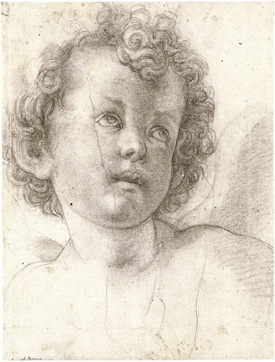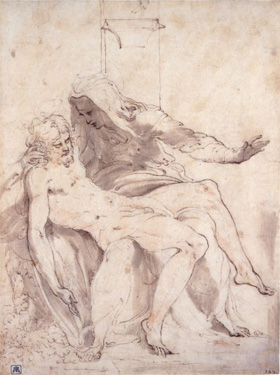To the Manner Born
John Haberin New York City
Bronzino Drawings and Rome After Raphael
I have often wanted to rename Bronzino, to maybe Porcelaino. His name gets his materials totally wrong.
The late Renaissance artist left any number of portraits in oil, especially of haughty, richly dressed women. Invariably, he lends them the clarity, smooth surfaces, and slightly rounded bulk of fine china. One always hesitates to get too close to a painting. After all, one might accidentally mar the paint—or, like a woman at the Met in January, fall and tear right through the canvas. (A Picasso will need repair.) With Bronzino, I like to think, a portrait would shatter. 
On paper, Agnolo Bronzino has a wholly different texture but still an almost perfect finish. It is hard to believe that he did not intend presentation drawings, but he never did. Not one was for sale. Rather, he meant them as studies for his art. Along with their compulsive finish, that makes them a double window onto his mind.
It also makes his drawings at the Met almost a low-budget retrospective. Together with "Rome After Raphael" at the Morgan Library, they describe art's travails in the late Renaissance.
Drawing on aspirations
Bronzino was a nickname anyway, for Agnolo Tori, perhaps on account of his complexion. It also suggests a touch of class, like a work of art. He had humble enough beginnings, though, as the son of a butcher. Born in 1503, he apprenticed, as was customary, as a preteen—but to Jacopo da Pontormo, not ten years older and the top artist in Florence. Bronzino later became court artist to Cosimo I de' Medici, and he hardly left town for the rest of his life. An artist back then was still, first and foremost, a craftsman and a servant.
At the same time, art's stature was changing, and Bronzino, like Pontormo, is almost synonymous with Mannerism, a period of change. Florence had suffered from the plague, and it had booted out the Medici clan, patrons to the early Renaissance, as tyrants. Momentum had shifted with the High Renaissance to Rome and the north. Rome itself had to recover after 1527 from a sacking by the troops of Charles I, the Holy Roman Emperor, and the challenge of the Reformation. Still, Cosimo was back, now duke of Florence and grand duke of Tuscany, with his wife Eleonora dedicated to the arts. They in fact founded the Uffizi museum—its long, narrow architecture itself a curious work of Mannerism.
Bronzino, too, had aspirations. As early as 1527, cherubic heads gaze upward toward something ineffable. Could it reflect Neoplatonism, which the Renaissance had brought back in fashion? Bronzino, also a poet, fully entered the Medici's intellectual circle. He also took on a huge workshop, despite increasing competition from Giorgio Vasari, whose Lives of the Artists relegated him to the ash heap of history. Yet he worked right up to his death in 1572, including a gift from Florence to Francis I, king of France.
No wonder he had no time for Renaissance drawing for its own sake. His earliest sketches have one function, of learning from his teacher. He and Pontormo sometimes took the two sides of a single sheet, the back turned sideways. Rumor has it that they also shared the same bed. His late drawings have another function, like many Renaissance drawings, of workshop models for frescoes and tapestries. That leaves few portraits on paper after all—and none of women.
This is not a good time for blockbuster retrospectives anyway. However, with sixty sheets, the Met somehow has all that survives on paper, in a collaboration with the Uffizi and Florence's Polo Museale Fiorentino. It has very early drawings, when attribution to him or his master is difficult to impossible. It has Bronzino on his own thinking aloud—reworking a face twice over on a single sheet to firm up a dimpled chin. An early sheet offers chaotic shading and, separately, a bare oval outline marked over with a cross. It treats figure painting as architectural plans or twentieth-century Italian Futurism.
The show has plenty of workshop activity, including a drawing by Bronzino alongside an almost exact copy. (Hint: the copy shows less hesitation.) It hauls out the Met's painting by Bronzino, with radiography results, as a kind of second exhibition. Compared to what he painted over, the artist seems to have simplified the gestures and props. Maybe the young man came to his studio determined to show off his style and learning. Mostly, though, the Met shows the evolution of the artist and the late Renaissance, surprisingly like that of Jan Gossart in the north.
Polishing up Mannerism
Pontormo belongs to the first generation of Mannerism, closest to the High Renaissance and in tormented reaction. Where Parmigianino introduces distended necks and Rosso Fiorentino both wooden and fiery forms, Pontormo has slowly melting bodies—like Michelangelo on drugs. They also have a heightened self-consciousness akin to one version of Postmodernism, and indeed one photographer, Irene Caesar, has put me through Mannerist poses. Amazingly, Bronzino starts out with Pontormo's stronger, bulkier anatomy and long brushstrokes, as if weighed down by the force of gravity. Of course, he ends up closer to today's version of Postmodernism, with its polish, distance, star system, and plenty of sex.
He painted his sexiest work, or at least his silliest, around 1545 for King Francis. Cupid fondles a nude Venus, Venus fondles a fruit, Father Time parts the curtain, and masks lie on the ground—while others shriek, cower, or bring gifts of appeasement. You would, too. On paper, however, the eroticism is more indirect and more directed at males. Bronzino loves curly hair and men seen at full length from the back, leaning upward or bending over. Their turn their back and their butt on the heroic Renaissance.
He starts with simple stories, like the Holy Family. Yet he subjects them to Mannerism's breakup of the tight Renaissance pyramid, and the tricks will only get more and more intricate. Men seen from behind stand on tiptoe. In this way, Bronzino pushes the Renaissance contrapposto, the full-bodied Renaissance quarter turn, to the point of weightlessness. He combines black chalk outlines with wiggly but disciplined shading, modified here and there by rubbing. Only occasionally does he add touches of pink or white, although one could mistake the intense highlights for white chalk.
He evolves by the 1540s toward heavier outlines and quirkier anatomy. Back muscles, as with Hendrick Goltzius, could pass for a knotted fabric or a bed of walnuts. With more widely ranging commissions, the narrative gets harder to follow, too. To explain the Pharaoh's dream, Joseph points upward, as if to something that his brothers can see. Of course, Joseph is a young man of ambiguous gender and curly hair. He also points past characters at the top, themselves gesturing madly past one another.
The whole mess squeezes into a closed circle flattened almost into a plane. Rocks give the shallow space the enclosure of an architectural niche or a tomb. Yet the characters still spill over the right-hand side, so that nothing quite fits. From a few feet away, one sees only a decorative weave. Mannerism has become a dream all its own—of elegance, art, death, and confusion. It really has become relevant to art now.
For all that, Bronzino works from life. With those early cherubs and their upward gaze, he is basing even angels at the base of a painting on observation. In another study from the late 1520s, a young man has a bare head, awkwardly parted lips, a broad nose, and the loose growth of a beard hardly discernible from shadow. The finished portrait will correct all of that. Bronzino does a lot of correcting, wiping out the more meaningful emotions of Pontormo's time or, now and again, today. Yet, again like art today, the turn from agony to manner sustains self-conscious reflection.
Collapse and recovery in Rome
After Bronzino in Florence, care for a fuller picture? "Rome After Raphael" spans the century, from the High Renaissance to the first signs of the Baroque. Raphael himself made a mark on the next generation with his Renaissance tapestries. From its own holdings, the Morgan Library displays rare volumes, including the Farnese Hours and an important architectural codex. But its heart is drawing—and the shifting tides of Mannerism in Rome.
Rome had the task of recovery, but hardly as it was. The eighty drawings include two plans for St. Peter's Basilica, one by Raphael. Its construction alone took from 1506 well into the next century. However, the real task came after 1527, when plague and the sack of Rome left the city a shadow of its glory, with half its former population. And the growth in the Counter-Reformation came less through public programs, grand designs, and the Vatican than with private palaces and country estates. Those also supply the setting for drawings, of both religious scenes and common life.
The real action came earlier, though, even before obvious disaster, and so did Mannerism. Raphael and Michelangelo dominated the scene, through their example and their circles, and both went over early to the dark side. A finished but feathery sketch for the Colonna Altarpiece in the Met shows Raphael at his most balanced and calm. Appropriately enough, the small panel depicts Jesus in the garden accepting his fate. Even earlier, though, his designs exceed the clarity and focus of the High Renaissance. In a later metalpoint, for the Vatican tapestries, a fiercely muscular male flies right through the picture plane, to symbolize an earthquake.
Naturally Michelangelo gets surlier still. In his Annunciation the Virgin cowers less from her assigned future than from the onrushing angel. Four impulsive drawings of David and Goliath turn the battle into a wrestling match or a brawl. Raphael died in 1520, and Parmigianino fled the city soon after.  First, though, the latter did as much as anyone to introduce the new style, in all its instability and arch reflection on art's immediate past. He draws Michelangelo's Pietà in almost a state of collapse.
First, though, the latter did as much as anyone to introduce the new style, in all its instability and arch reflection on art's immediate past. He draws Michelangelo's Pietà in almost a state of collapse.
They are not the only ones obsessed with motion. Indeed, they suggest just how much Mannerism's breaking up of the Renaissance pyramid led, ultimately, to the Baroque and Gian Lorenzo Bernini. First, though, art had to go through some boring stretches. Raphael chose students like Giulio Romano or Polidoro da Caravaggio (no, not the Caravaggio) for professionalism and little else. And Michelangelo, who banished assistants entirely from the Sistine Chapel, may have let sexual longings get in the way of artistic standards. The slick next generation, like the Zuccaro brothers, are a far cry from the agonized experiments of the 1520s.
Still, Polidoro's resting cows have a quiet respect for the everyday, almost like the great Dutch landscapes yet to come. And then the Baroque really does come, if only a taste of it. Annibale Carracci's fat-laden Flying Putto already hints at its excess. Yet the least earthy of the Carracci brothers also uncovers an Eroded Riverbank with Trees and Roots. It fills a sheet with its slippery heights, dense texture, and palpable mass. Something had to crumble in the 1590s, and something else had to put down roots.

"The Drawings of Bronzino" ran at The Metropolitan Museum of Art through April 18, 2010, "Rome After Raphael" at The Morgan Library through May 5. Following repear in its six-inch tear, Picasso's "The Actor" went back on display at the Met on April 20.




